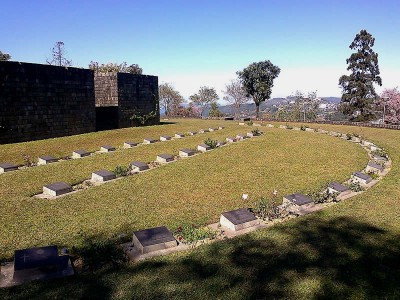Kohima Travel and Tourism Guide
Kohima, the Capital of Nagaland State, has lots of historical backgrounds. One of the most significant chapters in the history of this picturesque City is the British India Government occupying it and later becoming their battlefield fighting against the Japanese troops during the Second World War in 1944. After 69 years of this historic British-Japanese war fought in this region (Kohima-Imphal), it was finally adjudged as the “Greatest British Battle” ever fought on this planet. The present “Old DC Bungalow” which has been already converted to “The Heritage Bungalow” in 2009 and used for the commercial purpose by maintaining Suits, Conference Halls, and other facilities since then. This is the bungalow where Sir Charles Pawsey, a British colonial administrator, served as the Deputy Commissioner of the then Naga Hills during the Burma campaigns of 1942 to 1944. The part of this battle centered on Sir Pawsye’s bungalow was known as the Battle of the Tennis Court, because this Tennis Court of him was there. Showing great bravery and loyalty to the local Naga people, Pawsey refused to leave Kohima during the siege by the Japanese that lasted from 5 April to 20 April 1944, and did what he could to bolster morale and support Colonel Richards the Garrison Commander. The Nagas remained completely loyal to him and by way of thanks their tribal leaders were introduced to Lord Mountbatten at Kohima in August 1944. The advancing Japanese troops could be halted by the British at this war by coordinating their troops from Imphal side. The present Raj Bhavan and Old DC Bungalow areas should be rather preserved and declared as War Memorial Sites and opened to visitors. The various war-related documents, artifacts and wreckages collected from in and around Kohima and adjoining villages should be displayed in such War Memorial Site. Such War Memorial Site with the interesting items, comments, write-ups, photographs, would be a pride of the Nagas and the future generations would know such important histories from such monuments. We have many other locations, buildings, offices which have historical attachment over the years. The Kohima Local Ground, Old MLA Hostel, Old Secretariat, Old DC Office (already dismantled and already replaced by new one), Old Kohima Town Committee Office, Naga Hospital Kohima, etc.. There will be others too. All these are needed to be preserved. If they are no longer used, then they should be renovated without changing the original structures to be preserved. Such buildings, locations, structures, inscriptions on stones of the past if preserved as “Heritages” would only depict the past pride and history. These are important areas we have to seriously think over and never attempt to destroy them. It is very simple that by destroying them, you are only destroying history and without them, you are left unguarded to defend your people in future. The Kohima Village (Bara Basti) has its own history as the second largest Village in Asia. We should think of building a Museum in the Village with various historical records like artifacts, items and names of those who made significant contributions for the growth of Kohima, defenders of Kohima from external aggression in earlier days. It will definitely attract tourists, researchers, besides reminding the younger generations of their past forefathers and histories of the Angamis in the Kohima Village. It is regrettable to say that the Capital City of Nagaland continues to be experiencing underdevelopment particularly in road and water supply sectors, which are essential for the City development. The expansion of the Capital City hardly takes place since its inception as full-fledged State in 1963. But over the years, the State witnessed the population explosion and also sudden rise of vehicles. Roads are little and the overcrowded vehicles have today become nightmares for the denizens of Kohima. Traffic congestions have become a major problem in Kohima City. It is simply impossible to develop, progress, and expand Kohima City unless the Angamis of Kohima Village take the lead. Because they are the landowners and by tradition and customs, the Government cannot do anything as far as land is concerned. The conditions of the present State Capital is very unpredictable if one carefully studies. The capital roads are urgently needed for expansion which is the single most important area to be thought of. The building bylaws in the Capital region should be enforced. The proper drainage system should be constructed with quality materials. Encroachment of Government lands by private parties or individuals should stop as such practices have been going on over the years without any sign of solution. At the same time, the Government also should immediately stop allotting Government land or old Government bungalows to private and individual parties. Such practice is only making position and status of the Government extremely vulnerable. It is so painful to see that our youth are not given space they need. We need to have centers for entertainment and recreation in the Capital City areas. The Government used to come up with various projects like City Convention Center, Cultural Complex, etc. and why not think of providing some of youth oriented centers with modern facilities. The parks are needed for Cities. We do have one far off the City – beyond IG Stadium. It is good to have at least one such park in the City areas.








